Signs That You Might Need Braces
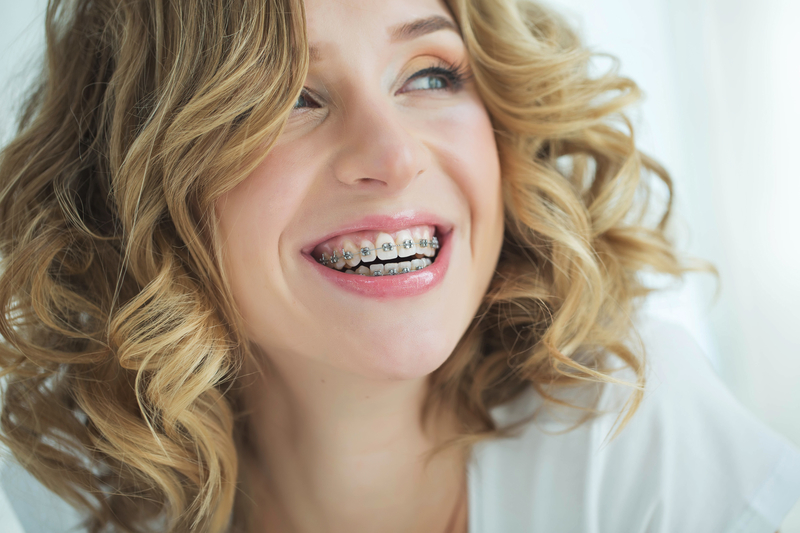
For many patients, getting braces is a big decision that affects oral health. How do you know whether you or your child needs braces, though? Some symptoms are obvious: misplaced or crowded teeth, or teeth that don’t meet normally. Other signs that you need braces are more inconspicuous, though, such as biting the cheek or a jaw that pops or shifts. While some of these symptoms are more serious than others, orthodontic care is the way to go to alleviate pain and correct any underlying issues. Learn about what signs you should be looking for to decide if braces are right for you with these tips!
What To Look Out For
As our teeth begin to erupt at a young age, they can fill into improper spaces or cause problems with adjacent teeth. Crooked or misaligned teeth aesthetically aren’t very pleasing for people, and most patients end up receiving orthodontic treatment during some point in their lives. Orthodontic problems don’t always mean crooked teeth, though. While there are some obvious signs that you might benefit from orthodontics, such as crowded teeth or an underbite/overbite, there are other symptoms that are less noticeable but equally as undesirable. The American Association of Orthodontics recommends that children have their first orthodontic visit between the ages of 7 and 8, but if certain complications are present, your child does not and should not wait until that age to be seen. If you have a young child, look for some of the following symptoms that warrant orthodontic care:
- Thumb or finger sucking
- Early, late or irregular loss of baby teeth
- Difficulty in chewing or biting
As children age, orthodontic problems will begin to show themselves, but some don’t appear until adulthood. No matter your age or prior orthodontic care, there are other symptoms that indicate a problem and should be addressed by an orthodontist. If you are struggling with a popping jaw, have to breathe through your mouth on a regular basis, are constantly biting your cheeks, and/or noticing teeth or jaws that are out of proportion to the rest of your face, you should have an orthodontic consultation. While many of these symptoms seem harmless or aren’t very noticeable, they can have long-term consequences that can negatively affect your oral health. Braces can remedy these issues so that your oral health isn’t compromised. It’s never too late for you to take charge of your oral health and get the smile that you deserve!
Advantages of Early Orthodontics
Not all kids will need orthodontic care, but many will. Meeting with your child’s dentist early on will help them determine whether your child would benefit from orthodontic treatment. If you have a child who needs an orthodontic issue remedied, there are certain advantages that come after receiving braces. Having your child evaluated by an orthodontist can help he/she observe the progress of incoming teeth, guide teeth into their ideal positions, monitor face and jaw development, detect hidden dental issues and reduce the risk of impacted teeth. For young children, orthodontic visits can sometimes be scary. Nonetheless, child orthodontic visits are simple and non-intrusive, so as to keep your child comfortable and happy. At Belmar Orthodontics, we do our best to give your child the care they need while making sure that their fears and questions are addressed. For adolescents, our options at include aesthetically-minded treatment options that will help your teen feel less self-conscious about braces. Braces can sometimes be seen as “dorky” or “uncool” for teens, but the list of options your teenager can choose from will give them plenty of choices to get straight teeth while still looking cool. Good oral health habits are started at a young age, and bringing your child in to see the orthodontist will help them establish those habits that will last a lifetime.
How You Can Benefit From Adult Orthodontics
Against popular belief, braces and orthodontic care aren’t just for kids and teenagers! In fact, one in five orthodontic patients is an adult; in just the U.S. and Canada alone, more than a million orthodontic patients are adults! You, as an adult, can benefit from the same care that young patients do and fix the orthodontic problems that you’ve been suffering from since childhood. As long as your teeth are healthy, you can receive orthodontic treatment at any age. The most common benefits of adult orthodontics include the following:
- More discreet treatment methods
- Correction of lifetime dental issues
- Faster treatment time than previous treatments
- Increased confidence and self-esteem
It’s important to note, however, that any previous orthodontic problems, such as periodontal disease or decayed/missing teeth, will need to be addressed before an orthodontic appliance can be placed. Once those issues are fixed, you’ll be fitted with braces and can continue your life just as usual. If you so choose, you can even opt in for hidden lingual braces or Invisalign clear, which will get you the straight teeth that you want while being completely unnoticeable. Speak with your orthodontist to determine which braces would be best for your needs before making any decisions.
Staying On Top Of Your Oral Health
Before any patient can receive orthodontic treatment, the health of their teeth, gums and mouth will first be evaluated. For this reason, it is important that children and adults alike are brushing twice a day and flossing on a nightly basis. The foods we eat also affects our oral health, as well. Especially during orthodontic treatment, certain foods, like sticky or sugary candies and food, can damage orthodontic appliances and make it easier for tooth decay to develop as plaque builds up on teeth. Brushing and flossing will partly diminish the effects of these foods, but not entirely. Make sure that you and your children are eating a healthy diet with minimal sugary snacks to avoid dental complications during treatment.
To ensure good oral health during and after orthodontic treatment, schedule an appointment with Belmar Orthodontics at (303) 225-9016 for a consultation.
Interesting Facts About Teeth and Dentistry

Our teeth are one of the most important parts of our bodies, and they are each unique to us. Our teeth are like a fingerprint: they are individual to us and never the same as anyone else’s. Teeth perform specific functions that are essential for speaking and eating. Our teeth have enamel, which is the hardest substance in the body and it protects our teeth from decay. The more that we learn about our teeth, the more important it is for us to take care of them. Find out what all our teeth do and how they help us with this guide!
Facts About Dentistry
For hundreds, and even thousands, of years, dentistry has been an important aspect of human’s lives. Even though dental technology and knowledge might not have been as well known a few thousand years ago, our ancestors still understood the importance of taking care of their teeth. People have been caring for their teeth for centuries, and historians have found evidence of dental care dating back to 5000 B.C. in ancient Egypt. The Egyptians would use crushed eggshells and ground animal hooves to clean and polish their teeth, before toothbrushes were invented. The first toothbrushes that were used anciently were actually twigs, or tree bark, that our ancestors would chew on, hoping that the frayed ends would clean their teeth. It wouldn’t be until the 1700s when a British inventor created an adapted version of a toothbrush that he had seen in China, one with a bone handle with boar bristles inserted into small holes that lined the brush and then secured with wire. Even up to the 1930s, toothbrushes were still rudimentary, until brushes with nylon bristles and ergonomic handles were developed, which is what we still use today.
Facts About Teeth
Although oral hygiene was important to our ancestors, little was known about the function and specifics of teeth that modern technology has allowed us to learn about in our day and age. Teeth are the hardest substances in our bodies, and enamel helps keep them strong and durable. We use teeth to eat, speak and chew, so they’re an important part of how we live. Even though they are hard, white and contain calcium, teeth are not bones! They cannot heal themselves or grow back if they sustain damage, so it’s very important that we are careful with what we eat and the activities that we engage in to avoid any unnecessary trauma. Additionally, teeth contain stem cells. Some researchers are even trying to use dental stem cells to regrow human teeth, which, if they can do it, would mean that we could replace lost adult teeth for the first time in history. Not only do teeth have stem cells, but they are also unique to each one of us and tell a story. Each tooth in our mouths is unique and different from the rest, and never is identical to someone else’s. Our teeth reveal how old we are, what we eat and even areas of the world that we have lived in! They are a lasting record of our life’s history.
Our mouths, and the teeth that are found therein, perform amazing functions that facilitate our ability to eat and digest food properly. Although they may be amazing, our mouths have some unusual quirks that most people don’t know about. The following are some of the weird facts about our mouth and teeth that one should think about:
- Teeth form in the womb, months before a child is even born. The crowns of babies’ first 20 teeth are already under the gumline when they are born, waiting to erupt.
- The average human produces 25,000 quarts of saliva in their lifetime, enough to fill two swimming pools.
- Plaque found on teeth contains more than 300 kinds of bacteria.
- Humans spend 38.5 days of their life brushing their teeth.
Good Dental Habits To Have
Now more than any generation before us, we have a limitless amount of options to choose from to protect our oral health and develop strong, healthy teeth. Our teeth do so much for us, so it’s important that we do everything we can to protect them. First and foremost, brushing and flossing should become part of our daily routine. Especially if your or your child has braces or an orthodontic device, maintaining a strict brushing and flossing regimen will prevent tooth decay and cavities. Brushing removes debris on the surface of the tooth while flossing removes food particles that can get stuck between teeth or near the gumline, where plaque can easily build up. Furthermore, regular checkups for both you and your child with your dentist and/or orthodontist will allow them to monitor teeth movement and keep your teeth as shiny and beautiful as possible.
For more information on what you can do to protect your teeth with or without braces, call Belmar Orthodontics at (303) 225-9016! Our dedicated team is committed to helping you and your family receive the care that you need and get the smiles that you deserve!
Why Is Orthodontic Care So Important?

Many patients receive orthodontic care during childhood or early adolescence. As modern technology has advanced, so has the need for orthodontic care in patients of all ages. Whether your symptoms are severe or not, orthodontic care can help monitor face and jaw development, reduce the risk of impacted teeth and correct life-time dental issues. Early detection and treatment are essential for good oral health and maintaining a beautiful smile. No matter what your age is, find out how orthodontic care can benefit you now and what effects it can have on you in the future with this guide!
Benefits of Orthodontics
Just like any other product you buy or activity that you participate in, orthodontics is an investment. It is an investment of time, money and patience, but the results can be life-changing. There are a variety of options to choose from when receiving orthodontic care, and many are so discreet that you hardly even notice that they’re there. Orthodontic treatment helps establish good oral health and can pave the way for a healthy smile now and in the future. A healthy bite and a good-looking smile is just as important at age 60 as it is at 16, and orthodontic treatment is the way that you can ensure that you have both. For kids, some benefits of early orthodontics include:
- Observe the progress of incoming teeth
- Guide teeth into their ideal positions
- Monitor face and jaw development
- Reduce the risk of impacted teeth
- Detect hidden dental issues
As technological advances in dental science has improved, there are more options than ever for adults seeking orthodontic treatment. Many times, adults have been struggling with specific orthodontic issues since childhood that have never been resolved, but orthodontic care can fix that. Even though orthodontic treatment is most successful during adolescence as teeth and jaw bones are still developing, adults can still enjoy improvements to their oral health with orthodontic treatment at any age. Whether it be traditional metal brackets or other discreet options, like Invisalign, there are plenty of ways to straighten teeth. Some of the many benefits that adult orthodontics provide include:
- Faster treatment time than former orthodontic techniques
- Correction of life-time dental problems
- More discreet treatment methods
- Increased self-esteem and confidence
When To See An Orthodontist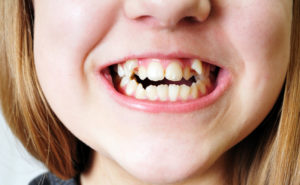
The American Association of Orthodontics recommends that children have their first orthodontic visit by age 7 or 8 to prevent the progression of any orthodontic issues that may be present. Even if you do not detect any dental issues with your child, it is still important that they get evaluated early on so that their teeth and jaw development can be properly monitored. If you notice that your child has bite problems or protruding teeth, it is time for them to see an orthodontist. Bite problems, such as a crossbite, cause the jaws to develop unevenly, while protruding teeth can be fractured or injured much easier than normal teeth. For both children and adults, there are certain signs that you should look out for that may necessitate an orthodontic visit. Some of these symptoms include difficulty chewing or biting, jaws that shift or make sounds, grinding/clenching teeth, biting the cheek or roof of the mouth, protruding teeth, and facial imbalance or asymmetry (facial features out of proportion). Even oral habits, such as thumb-sucking, affect how the mouth develops and can necessitate orthodontic treatment. For many patients, orthodontic treatment isn’t necessarily needed but is wanted to improve self-confidence and give them a prettier smile. Whatever your reason is, orthodontic care can help you reach your goals and improve your oral health at any stage in life.
How You Can Start
After you make the decision to begin orthodontic treatment for yourself or your child, the first thing to do is schedule an appointment with your orthodontist for a consultation. This consultation will allow both of you to establish appropriate goals, address concerns and develop a treatment plan. Additionally, taking good care of your teeth at home by maintaining an oral health regimen is important to keep your teeth healthy and prepare them for orthodontic treatment. Consistent brushing and flossing each day will protect your teeth and gums from plaque, tooth decay and cavities. During orthodontic treatment, it’s essential to maintain this routine to avoid any complications from occurring, which can extend treatment time and be costly to fix.
If you have questions regarding orthodontic treatment for yourself or your child, call Belmar Orthodontics at (303) 225-9016! Our talented staff is dedicated to you and your oral health goals, and will strive to help you get the beautiful smile that you deserve!
Teeth Cleaning Habits To Have With Braces

Good oral hygiene is one of the most important goals that we should all have to maintain the health and strength of our teeth and gums. Once we get braces, however, our oral hygiene regimen will change to account for the new appliance in our mouths that we will have to clean around. Whether you have traditional braces or lingual braces, cleaning around the brackets and wires is essential in preventing cavities and tooth decay. There are many options to choose from to clean between teeth, such as a proxabrush, and other tools to thoroughly brush around the brackets, such as an electric toothbrush. Find out what all you can do to keep your smile healthy and bright with braces with these tips!
Extra Care For Teeth During Orthodontic Treatment
Orthodontic care is one of the most helpful and important dental treatments that patients have readily available to them. While there are many versions of braces that help straighten our teeth and fix misaligned bites, there are certain precautions that we need to take to ensure proper care for our orthodontic appliances and teeth. Brackets and wires in the mouth make it easier for food particles to get stuck in, which can lead to dental problems, like cavities. Proper oral hygiene is essential during your time with braces to avoid any preventable issues that can lengthen your treatment time or need special care to be fixed.
Since braces naturally create nooks and crannies where bacteria can hide, it is important to maintain a good oral hygiene regimen everyday so that you can avoid tooth decay and gum problems during orthodontic treatment. If teeth and brackets are not kept clean, permanent damage can occur to the tooth enamel, as well. When this occurs, white spots (tooth decay) can begin appearing on the teeth where the enamel surface has lost minerals, which cannot be reversed. Bleeding or inflamed gums, called gingivitis, is also common whenever patients don’t clean their teeth thoroughly enough with braces, and it can be very painful. While it is not likely that all of these issues will occur if you miss brushing your teeth or flossing well a few times, you will be more prone to an increased risk, which will hurt your oral health and complicate the rest of your orthodontic care.
Teeth Cleaning Options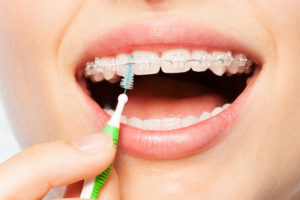
Although cleaning your teeth with braces isn’t too difficult of a process for most patients, there are some tools that you can use to better clean around the hard-to-reach areas in your mouth and make your time cleaning more efficient. First and foremost, make sure that you (or your child) are brushing after each meal. It may seem insignificant, but brushing after you eat removes food particles that are stuck in braces, reduces staining and prevents bacteria buildup. Secondly, use a threadable floss or floss threader to clean underneath the wire of your braces. A floss threader works by inserting the pointed end between the teeth and under the archwire. From there, move it back and forth until it is able to thread the floss between the teeth. Then, you can floss the two teeth, on either side, to remove all food that may be stuck there. If you’re having trouble with your floss getting stuck, consider using waxed floss, which slides between the teeth easier and doesn’t get snagged.
After brushing and flossing, using a proxabrush is helpful in cleaning between each bracket. Commonly referred to as an interproximal brush or “Christmas tree brush,” a proxabrush is placed between two brackets, below the archwire, and uses an up-and-down motion to remove any lodged food particles that brushing and flossing can’t get to. Clean the brackets with the proxabrush on both sides, starting either up from the bottom or down from the top, and repeat between each tooth. Another option for hard-to-reach areas is an oral irrigator, which uses a pulsating stream of water to remove plaque and food debris. Mouthwash is also a helpful tool to kill and bacteria that may have been left after brushing and flossing. For an extra clean, try using an electric toothbrush to maximize cleaning and brush those difficult areas of the mouth that are hard to reach.
Braces-Friendly Diet
The foods we eat and the diet we have affect our oral health and can interfere with orthodontic appliances. Eating sugary or starchy foods can let plaque develop around the brackets, which can lead to cavities, staining or even gum disease. Sticky or chewy foods, such as caramel, taffy, chewing gum and corn on the cob, should also be avoided as they can easily become stuck between brackets and be difficult to remove. Hard foods, such as candy, beef jerky, nuts and popcorn, are also no-nos as they are known to break wires and loosen brackets. If you’re going to eat hard or crunchy foods, such as apples or carrots, make sure to cut them into small, bite-sized pieces to avoid any possible damage.
Regular Orthodontic Checkups
Even if you or your child are following these rules, it is essential that you visit with your orthodontist regularly so that they can monitor teeth movement and adjust any wires or brackets. Your orthodontist or hygienist can show you how to use the tools previously described and give you additional teeth cleaning supplies to aid you during treatment. For more questions about how to clean your teeth with braces or what foods to stay away from, contact Belmar Orthodontics at (303) 225-9016!
Space Maintainers and Permanent Teeth
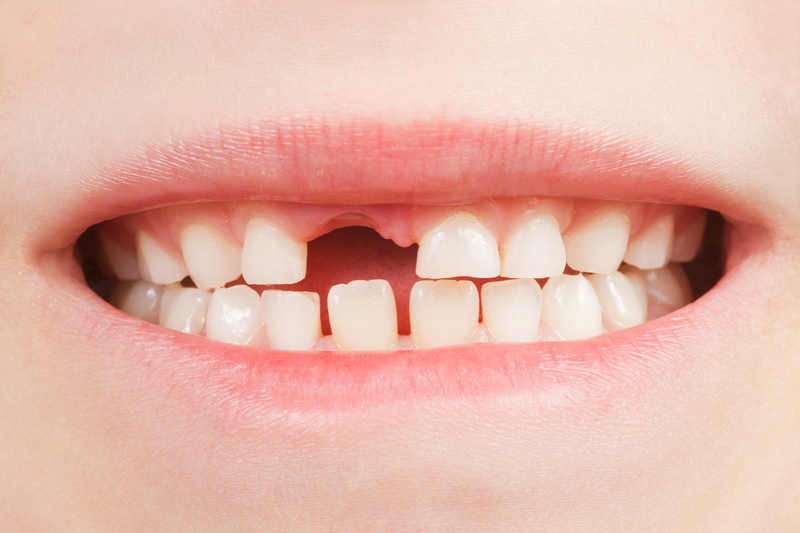
Whenever a child loses a tooth prematurely, a space maintainer may be needed to keep the space open so the permanent tooth can grow in correctly. Losing a baby tooth is a natural occurrence, but some baby teeth must be extracted due to dental decay. A space maintainer is a custom-made appliance that helps permanent teeth grow in correctly and prevent future oral health complications. If you are worried about the gap in between your child’s teeth, learn how a space maintainer can keep your child’s teeth straight and allow for proper tooth development!
Why Baby Teeth Fall Out Prematurely
Most children get their first full set of baby teeth by the age of 3, and these help them eat their food while serving as placeholders for their future permanent teeth. Occasionally, baby teeth are lost prematurely or permanent teeth erupt later than they should, so space maintainers have become a popular way to support the child’s mouth until the gaps are filled with permanent teeth. There are many reasons why children lose their baby teeth earlier than expected. For one, some experience trauma to the mouth, such as tripping or getting hit in the mouth with some object. Others lose teeth due to “baby bottle decay,” which occurs whenever a child falls asleep at either breast or bottle, or walks around with a bottle for large amounts of time. The sugar content in the milk causes enamel to decay and cavities to appear, which can lead to premature tooth loss. Genetic influences can also affect whether permanent teeth develop or not, which can leave gaps in the mouth. Although rare, some children suffer from oral infections that are severe enough to cause tooth loss, but this is not as common as an injury or baby bottle decay. Even though losing baby teeth prematurely is not inherently bad, the consequences of not having a tooth in the space where a permanent tooth will eventually erupt can cause some complications with malocclusion that will need orthodontic care later on. Space maintainers provide the mouth with the proper space for permanent teeth to erupt into while ensuring that other teeth do not crowd that area until the tooth develops.
How Space Maintainers Help
Space maintainers basically “hold space” for permanent teeth once a baby tooth has been lost prematurely. When adult teeth are ready to come into the mouth, there may not be enough room because of the lost space. For this reason, dentists recommend space maintainers to hold open any spaces left by the missing tooth. These devices are typically made of acrylic, with loops and bands made of steel wire to hold them in position. Space maintainers ensure that your child develops their permanent teeth in the right locations while giving support to the surrounding teeth. Teeth are notorious for moving or becoming loose without the support of surrounding teeth, so space maintainers also help other teeth stay in their proper places and not move into the gaps where the missing teeth were once located. Space maintainers aren’t for everyone, though. If your child loses a baby tooth shortly before a permanent tooth is expected to develop, a space maintainer isn’t necessary. For those patients whose permanent teeth won’t be developing for an extended amount of time, space maintainers come in handy to guide those teeth into proper alignment whenever they do erupt.
Type of Appliances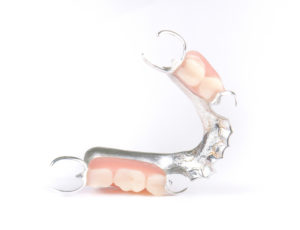
For those who choose space maintainers, they come in two different options: removable and fixed. Removable devices are made of acrylic and use artificial teeth to hold open the spaces. These are ideal for older children who are capable of removing and cleaning them on their own. For children with several missing teeth, partial dentures are another option to maintain the spaces in the mouth. Fixed maintainers are attached with dental cement to the teeth beside the gap. These are helpful for young children or those who have lost back teeth. Fixed retainers can be fitted on the upper or lower jaw to maintain space for front or back teeth. The device that your child will be given will depend upon the number and location of missing teeth in their mouth, but age is also considered, as well.
There are quite a few different options to choose from if your dentist recommends a fixed maintainer for your child. Some of the most popular options include:
- Lingual holding arch: Used to maintain space for lower back teeth on both sides.
- Band-and-loop device: Recommended when one or more baby molars are lost in one dental arch. Stainless steel wire that is held in place by orthodontic bands that allows the permanent tooth to erupt without blocking it.
- Distal shoe appliance: Fitted over the baby first molar and maintains the space for the permanent molar once the tooth is lost.
- Transpalatal arch: Fitted on the upper jaw to preserve space on both sides of the dental arch. Held in place by wire fastened around the surrounding teeth.
Each of these devices are custom-made to fit to your child’s mouth. The dentist will take impressions of your child’s teeth, then send that impression to the dental laboratory to create the appliance.
Advantages of Child Orthodontics
With the modern technology and tools that are available to dental patients, child orthodontics has become more popular and necessary to maintain the oral health of young kids. Especially if your child loses a baby tooth prematurely, visiting with an orthodontist early on can help detect hidden dental issues, observe the progress of incoming teeth, decrease the risk for permanent tooth extractions and guide incoming teeth into their ideal positions.
If your child is in need of a space maintainer or is having issues with crowded teeth, call Belmar Orthodontics at (303) 225-9016! Our team is dedicated to your oral health and is ready to help your family get the beautiful smile that they deserve!
Whitening Teeth With Braces
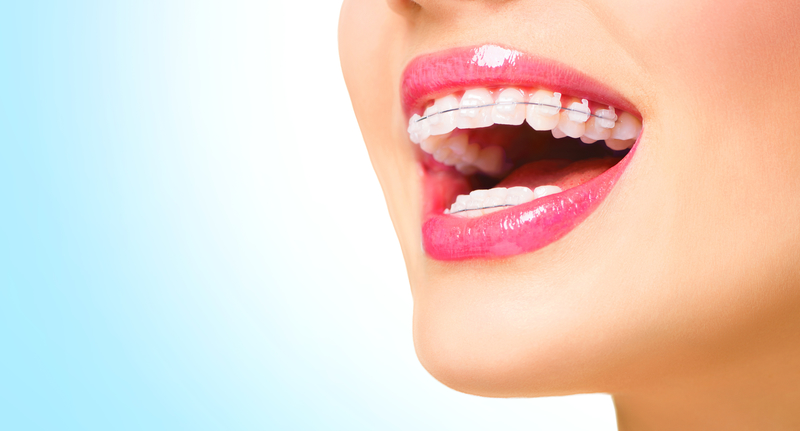
Keeping teeth clean during braces is an important part of your oral health regimen, but keeping teeth white with braces sometimes presents a problem. Teeth whitening with braces is a common practice that orthodontic patients have done to keep their teeth white during orthodontic care. Which teeth whitening treatment you use will depend on what type of braces you have. Achieving a whiter smile is not impossible with braces, but will need extra effort and care to protect your braces. Find out how you can both whiten and straighten your teeth at the same time with these tips and tricks!
In-Office versus At-Home Treatments
Teeth whitening has been a popular choice of treatment for dental patients for years now, but orthodontic patients can now receive the same treatment, too, while getting their teeth straightened at the same time. Keeping your teeth clean while undergoing orthodontic treatment is an important step in maintaining good oral health, and teeth whitening options can enhance that process. With the variety of treatment options that orthodontic patients now have to straighten their teeth, there are plenty of ways to whiten teeth while receiving care. For patients who prefer whitening their teeth at the dental office, one option that patients can choose is “chairside bleaching.” This process requires one or two office visits in which a strong bleaching agent is applied to the teeth combined with a special light to accelerate the whitening effect and lift stains. For patients with brackets on the front of their teeth, chairside bleaching can cause a two-tone effect after traditional braces are removed, so sometimes it is best to bleach after your treatment is over. For patients with lingual braces (on the backside of teeth), though, it is relatively easy to whiten teeth during treatment since teeth whitening focuses on the front of the teeth and not the back. Removable braces and retainers also allow for successful teeth whitening as they allow all of the teeth to be uncovered.
Many patients prefer at-home teeth whitening treatments over in-office treatments because it allows them the flexibility to decide when and where they whiten their teeth. For at-home treatments, gel similar to those used in dental offices will be given to you that is inserted into a customized tray which is fit to your mouth. The gel uses peroxide to bleach the tooth enamel and whiten the tooth. Even those with braces can use these custom trays after braces have been placed in the mouth. The trays have to account for the space that brackets use so the gel doesn’t displace the bracket from the tooth. With at-home treatments, though, there is a larger risk of sensitivity and gum irritation if bleaching material leaks out of the tray. Both options for teeth whitening allow patients the freedom to get the best results during their orthodontic treatment but still get the same benefits that braces offer.
Things To Consider
When deciding on which type of teeth whitening you should do, it is important to remember that the type of braces you have dictates what kind of teeth whitening you can receive. As teeth shift during orthodontic treatment, tooth sensitivity and gum irritation can increase when using mouth trays or teeth whitening strips at home. Traditional braces use brackets on the front side of the teeth to correct malocclusion while other options, like lingual braces, use brackets on the backside of teeth to straighten teeth. Whitening teeth with lingual or removable braces is much easier for patients than those with traditional braces as brackets prevent a good portion of the tooth from bleaching agents. For this reason, most orthodontists recommend using teeth whitening products once braces are removed for most effectiveness. If you do choose to use teeth whitener during treatment with traditional braces and you feel some sensitivity/tenderness, make sure to avoid whitening for a while to give your teeth a break. Chewing gum can also help with any pain you might feel from whitening agents, as well as using sensitivity toothpaste. For additional insights into what to expect when using teeth whitener with braces, meet with your orthodontist to discuss which option is best for your mouth.
Everyday Teeth Whitening
Many patients use everyday teeth whitening products to improve their smile rather than going to a dental office or using expensive products. As teeth whitening has become more popular, more and more products have been created to enhance smiles in the comfort of one’s home with a smaller price tag than traditional methods. For anyone, with or without braces, using a teeth whitening toothpaste is a great and easy way to whiten your smile and maintain good oral health at the same time. Even if you have sensitive teeth, there are still plenty of options for toothpaste that whiten teeth without putting your sensitive mouth at risk. There is also teeth whitening mouthwash that whitens and protects teeth from stains while freshening your breath at the same time. Switching from a manual to electric toothbrush can further whiten your teeth by polishing away surface stains that appear under braces. With all of the different dental items that can be tailored to your individual needs, you can have a whiter smile with braces in no time.
For more information on how you can whiten your teeth during orthodontic treatment, call Belmar Orthodontics at (303) 225-9016! Our team is committed to helping you and your family get the healthiest and brightest smile possible!
The Impact Of Straight Teeth On Oral Health
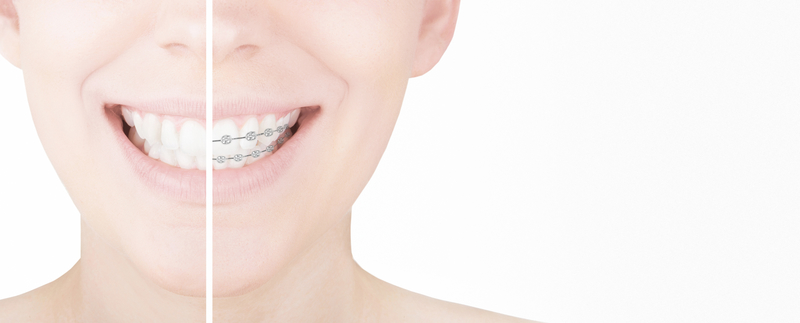
Many orthodontic patients use braces so that they can have straight teeth, but that’s not the only reason why orthodontic care is so important. Having straight teeth can minimize the likelihood of tooth decay and tooth loss while improving your bite, which affects your ability to chew and speak. Correcting crooked teeth can also improve your oral hygiene and strengthen teeth. Learn more about the positive effects that straight teeth can have on your oral health through this guide!
How Straight Teeth Can Help You
One of the main goals of braces is to create a straight smile and correct any orthodontic issues that may prevent teeth from remaining straight. While orthodontics does focus on straightening patients’ teeth, this is not the only purpose of receiving orthodontic care. Whenever a patient has malocclusion, or bad bite, caused by crowded or crooked teeth, daily oral hygiene can become a difficult task. Malocclusion can also stem from teeth that are out of alignment, or jaws that do not meet properly. Thumb sucking or accidents to the teeth can also cause malocclusion. As oral hygiene becomes more difficult to maintain, the likelihood of dental complications, such as tooth decay, periodontal disease, and tooth loss, increases. An improper bite that goes unaddressed can negatively affect chewing and speaking, and wear down tooth enamel. Correcting these problems is of utmost importance to your orthodontist as they seek to give you the best care possible. Orthodontic care that helps straighten teeth can decrease and ultimately eliminate the chances of any of these complications from arising. With straight teeth, patients can better brush and floss their teeth, which will help strengthen them, while easily monitoring any changes that may occur.
What To Expect With Orthodontics
As you begin your orthodontic treatment, there are a few tips that you should know to prepare yourself for what will be expected of you during your time with braces. Although there are some challenges with straightening adult teeth versus children’s teeth due to the pliability of the jawbone, modern technology allows any adult of any age the opportunity to correct crooked teeth with remarkable success. You will first meet with an orthodontist for an evaluation and orthodontics consultation to determine what option is best for your mouth. Any oral health issues, such as gum disease, will have to be resolved before you can begin treatment. Adults have a variety of options to choose from for their orthodontic care, with many discreet options, such as ceramic or clear braces, lingual braces, and Invisalign clear removable retainers, that are available for your needs.
For children, treatment is similar to that of adults and can start as early as the age of 7. Having an orthodontic examination early on can prevent the progression of orthodontic issues that are present and allow the orthodontist to monitor the development/eruption of teeth. Aesthetically-minded treatment options, such as incognito lingual braces, are available for young children who may be self-conscious about their orthodontic care. Most children and adults can expect treatment for 1-3 years, followed by a period of time in which a retainer will be used to keep teeth in their newly aligned positions. Regular dental and orthodontic visits will be necessary to track the progress of teeth and manage any plaque or tartar buildup that could accrue between teeth.
How To Keep Your Straight Teeth Healthy
Once you or your child finishes orthodontic treatment, it is important to continue certain oral health standards to maintain the health of your gums and teeth. Eating a healthy diet, with or without braces, while limiting the amount of sugary foods you consume, will prevent plaque that can stain or damage your teeth. Brushing with fluoride toothpaste and flossing each day will also prevent any plaque buildup, prevent cavities, and keep your teeth clean. Good oral hygiene is especially important for patients wearing braces because you are more susceptible to plaque buildup around brackets and underneath wires. For additional protection, consider using a mouth guard while playing any sports or activities that could damage your mouth, if hit. Creating a good oral health regimen before you start orthodontic treatment will help you have a healthy mouth during and once braces are removed.
For more information on the importance of straight teeth on oral health and what you can do to get the straight teeth that you want, call Belmar Orthodontics at (303) 225-9016! If you’re ready to change your smile for the better, our team is ready to help you reach that goal for you and the rest of your family!
Orthodontic Appliances Your Child Might Need

As orthodontic technology has improved throughout the years, so have the different appliances that are used to treat children with braces. Depending on their jaw and bone structure, your child may need an orthodontic device to help guide their teeth and jaw into proper alignment. These orthodontic appliances are used to maintain space in the mouth and allow for proper tooth eruption and movement. Find out what types of appliances are available and which is best for your child’s needs through these tips!
Benefits of Child Orthodontics
Many, if not most, dental patients will receive some form of orthodontic treatment during their lifetime. Even if one’s teeth doesn’t show any kind of orthodontic issues, it is advantageous that patients, especially children, visit with an orthodontist to maintain good oral health. The American Association of Orthodontics recommends that children have their first orthodontic visit between the ages of 7 and 8 to prevent the progression of any orthodontic issues that may already be developing. Orthodontic treatment can lead to healthy, beautiful smiles at any age, but is most beneficial when completed at an earlier age. Some benefits of visiting the orthodontist early on include observing the progress of incoming teeth, reducing the risk of impacted teeth, and monitoring facial and jaw development. Early orthodontic evaluations can discover hidden dental issues and decrease the risk for permanent teeth extractions, as well. Early detection of any dental issue is vital in maintaining good oral health for patients of all ages, and should be a goal that all children should obtain from an early age.
Types of Appliances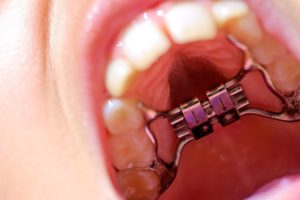
Whenever patients think of “orthodontia,” they typically think of braces. For young patients, braces are common orthodontic appliances that they can receive to straighten their teeth and correct any dental issues. Child orthodontics includes other appliances than just braces, though, and these appliances fulfill an important function in your child’s overall treatment. Orthodontic appliances change the way your child’s mouth works by correcting certain bone problems. Headgear, for example, guides the jaw into the proper direction by holding the upper jaw until the lower jaw can catch up with it. Retainers are other useful tools that keep teeth in the correct position after braces are removed, and most children will use some type of retainer during or after their treatment.
There are other orthodontic appliances that aren’t as well known but are used quite often in child orthodontics. The Nance “Button” is one of those appliances that uses a holding arch to maintain space in the mouth for children who have lost their baby teeth and are waiting for permanent teeth to grow in. If baby teeth are lost prematurely, the first molars might move forward into an incorrect position as they erupt because there is nothing holding them back. The Nance is an acrylic plate (the button) that covers a section of the palate with two metal bands around the back teeth to hold them into position until permanent teeth develop. This process helps maintain the proper space for permanent teeth to grow into. Another less-known appliance is the lower lingual holding arch, which does the same thing as the Nance but for the lower teeth. Two metal bands are cemented to the lower molars, joined by a U-shaped bar that rests behind the lower teeth. This keeps the back teeth from moving forward and maintains the space needed for future permanent teeth to erupt. Lastly, twin blocks are used to correct misalignments in the jaw that cause your child’s top teeth to stick out in front of the lower teeth further than normal. The blocks consist of two plates, one on the upper teeth and the other on the lower. These work together to bring your child’s lower jaw forward into the correct position, but is most successful when inserted while your child’s bones are still growing. They are the fastest-working appliances, and create quick results. Any of these appliances can be used in your child’s orthodontic treatment, so if you have questions about how they function or which one would be best to implement, make sure to ask your orthodontist.
What To Expect At The First Appointment
Most adult teeth erupt between the ages of 6 and 12, so whenever your child’s first permanent molars begin developing, the dentist will need to evaluate them to see how they work together. This process is called a “bite check,” and it helps orthodontists determine in what stage your child’s teeth are and what their treatment will require. The dentist will then decide which type of appliance would work best for your child and what instructions they will need to follow to get the best results out of their treatment. When using an orthodontic appliance, good oral hygiene will be necessary to prevent plaque buildup and other dental complications that could extend your child’s treatment time. Having your child brush and floss their teeth every day, along with cleaning whichever orthodontic appliance they’re given, will ensure that they get the healthiest and fastest treatment possible.
If your child is due for an orthodontic visit, or if they’re experiencing any of the orthodontic issues that we’ve discussed, call Belmar Orthodontics at (303) 225-9016 for a consultation to improve their oral health. Our dedicated team is ready to help you create a plan for your child to get them the smile that they deserve!
How Upper Jaw Expansion Can Benefit Your Child
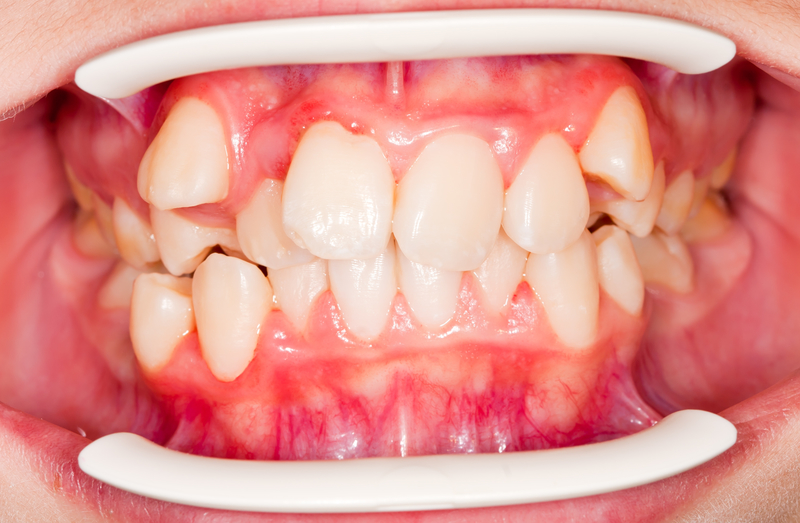
Upper jaw expansion is an orthodontic treatment that creates more space growth for developing kids by widening the circumference of the palate. This procedure helps correct crossbites, reduces overcrowding, and improves breathing ability. Most adolescents will receive this treatment before 16 years of age, but adults can also expand their upper jaw, if needed, as well. Read on to find out how upper jaw expansion works and what the advantages are with these tips!
Jaw Positioning and Malocclusion
Many patients deal with malocclusion, or crooked teeth and a poor bite. A poor bite refers to the way the upper and lower teeth line up, which is affected by the structure of the jaw. A “normal bite” consists of the upper teeth sitting slightly forward of the lower teeth, which allows for proper movement. Malocclusion is normally a cosmetic problem, but when it interferes with how teeth erupt, it can cause crooked teeth and tooth decay. A common cause of malocclusion is having too much or too little room in the jaw, which affects whether teeth grow in crowded or crooked. The shape and size of the jaw can also affect how severe someone’s malocclusion is, but thumb-sucking and tooth loss can also influence this process. For many patients, especially children, malocclusion is caused by a limited amount of space in the mouth for teeth to grow, so they either grow in crooked or the bite is altered. For this reason, many young dental patients receive upper jaw expansion treatments to allow more room in the mouth and prevent malocclusion. As more study and insight has been gained on the structure of the mouth, there are now more possibilities to fix incorrect bites, adjust occlusion and prevent crooked teeth starting from an earlier age.
Reasons For Upper Jaw Expansion
Upper jaw expansion is a specific treatment for widening the circumference of the palate to increase the perimeter of the dental arch in the mouth, which creates more space for teeth to grow. When there is enough room for teeth to grow, they are more likely to develop correctly. During childhood, palatal or maxillary expanders are used to aid this process. Through these expanders, dentists can help correct a crossbite that is caused by malocclusion. Normally, the upper teeth should close around the outside of the lower teeth, but when someone has a narrow palate, the opposite can occur and create a crossbite. As the upper teeth bite inside the lower teeth, an asymmetrical growth of the lower jaw can develop and change the symmetry of one’s face. This can cause serious complications if not addressed early on. Lastly, upper jaw expansion methods improve breathing ability, which is greatly affected by a narrow jaw. A narrow or deep upper jaw can make it difficult for a child to breathe through their nose and results in constant mouth breathing. While it doesn’t sound very serious, consistent mouth breathing keeps the mouth open at night, allowing for unfiltered bacteria to enter into the oral cavity, causing dry mouth and halitosis (bad breath).
Treatment Options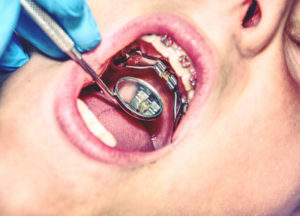
Upper jaw expansion is most successful when done at an earlier age while the mouth is still developing. For adults, those with a crossbite may only need a dental expansion instead of a palatal expansion, but may need surgery if palatal expansion is required to fix concerns. Depending on the age of the patient and the reason for treatment, a rapid palatal expander (RPE) may be used to increase the width of the jaw. The RPE is attached to the upper molars by bonding or cemented bands, and uses a special key that is used to widen the space by turning a screw in the appliance at certain points in time. This process puts extra pressure on the two halves of the upper jaw, which causes extra bone to grow between them. Gradually, by turning the screw with the key each day, the jaw widens to make room available for developing teeth. For adults, removable expanders can be used, as well, whenever the degree of expansion is minimal. Resembling a partial denture, removable expanders are typically made of chrome and recommended for adults as they more easily comply with treatment. After treatment, an orthodontic retainer may be given to maintain the space until all permanent teeth have developed. A third but least common option for expansion is a surgically assisted rapid palatal expander (SARPE), which is a combination of orthodontic treatment and surgery. This is used in the case that expansion cannot be achieved by the appliance alone. A custom appliance is made before surgery, and while during surgery, the upper jaw is intentionally fractured to separate it into movable sections. This allows the bone to grow between the fractures after the appliance is inserted.
Pros and Cons
Palatal expanders help straighten teeth, improve breathing and fix incorrect bites, but there are important suggestions to make note of. Since children are most likely to have one, a palatal expander, just like any orthodontic appliance, needs to be thoroughly cleaned each day to prevent plaque buildup and decay around the teeth. For young children, this can be difficult to do without help and can be easily overlooked, so parental supervision is essential. Additionally, the entire process can cost up to $3,000, depending on the degree of correction. For many, there is also some minor discomfort during expansion, but it is well worth it when you’re avoiding an inaccurate bite later in life.
For more information on which treatment option is best to fix yours or your child’s palate, call Belmar Orthodontics at (303) 225-9016! Our experienced team is dedicated to improving your oral health and getting you the smile that you deserve!
Diastema: What Is It?

A gap between the teeth, called “diastema,” are common among many dental patients and can be found between any teeth in the mouth, but usually between the two upper front teeth. Why do these spaces develop, and what are the differences between a diastema in children versus adults? Diastemata develop through a variety of reasons, such as misaligned jaw bones, missing teeth, and thumb-sucking. Not all spaces can be prevented, but many can be adjusted through orthodontic treatment. If you have a diastema that you would like to have treated, learn what your treatment options are through this guide!
Changes in Orthodontic Care
Orthodontic treatment options have been revolutionized through modern technology and dental science. Poorly aligned teeth have been a nuisance for dental patients for hundreds of years, and orthodontic work was even performed on willing subjects dating back to the ancient Egyptians and the Romans. From crude metal bands to catgut, archaeologists have discovered that even ancient societies performed orthodontic care on patients in an effort to straighten teeth. For those suffering from malocclusion, or misalignment, a common practice for moving emerging teeth into their correct position was by regularly pushing them with the fingers, a practice that has long been outdated since the invention of custom-fit metal appliances in the 18th century. Eventually, orthodontics treatment evolved into the process that we see today: brackets being cemented to each individual tooth with a metal wire attached to cinch the teeth together. Options for invisible treatments, such as lingual braces or even Invisalign, further allow patients to choose how they straighten their teeth. While there are so many options to choose from to decide how to straighten our teeth, how our teeth first develop and erupt in our mouth is a separate process. Since every patient is different and will experience a variety of dental issues, some patients may face something called “diastema,” which can have certain dental complications and be caused by a variety of reasons. Understanding how diastemata form and what you can do to fix them can give you the freedom to be in control of your oral health and appearance.
Gaps Between Teeth
Many people across the world are born with a diastema, or a gap between their teeth. These spaces can form anywhere in the mouth, but are most commonly found between the two upper front teeth. Both children and adults can have a diastema, and many times a child’s diastema will disappear once their permanent teeth grow in. While some gaps are relatively small and barely noticeable, others can be quite large and can cause cosmetic issues for some patients. While relatively harmless, most patients who fix their diastema do it for aesthetic reasons.
There are a variety of reasons why a diastema develops. A mismatch between the size of the jawbone and the size of teeth that develops can cause gaps to appear, or even too small of teeth (or a missing tooth) can create spaces, as well. Sometimes a diastema can be caused by an oversized labial frenum. This part of the mouth is a piece of tissue that extends from the inside of your upper lip to the gum just above your upper front teeth. Occasionally, this will grow too much and pass between the two front teeth, causing a gap. Bad habits, such as thumb sucking, can also lead to gaps between the teeth as the movement of the thumb tends to push teeth forward, creating a gap. A diastema can also develop due to incorrect swallowing reflexes. Normally, the tongue will push against the roof of the mouth when swallowing, but some people’s tongues may push against the teeth, which causes separation. This is called a tongue thrust. Lastly, gaps can form from periodontal disease in which inflammation damages the gums and teeth, which can cause teeth to loosen and fall out, or decay.
Treatment Options
A diastema can result from a mixture of orthodontic problems, or it can develop on its own. Many people who fix the gap in their teeth do it for appearance, but for those patients who have missing teeth, they might need to have a dental implant or bridge inserted. More often than not, braces are needed to close the gap between teeth, no matter where the gap is located. Fixing a diastema affects the entire mouth structure, so braces will be installed on both the top and lower teeth for proper alignment. If your diastema is due to an oversized labial frenum, a frenectomy will be performed to help the gap close on its own. If there is any sign of gum disease, periodontal treatment will be needed first to restore gum health before any braces will be put on. See open bite symptoms and causes.
Keeping The Gap Closed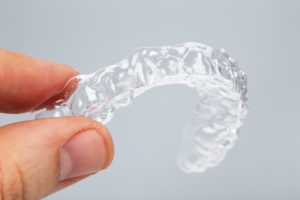
Spaces will tend to stay closed when done through orthodontic or dental repair. To prevent any gaps from developing in the future, make sure to wear your retainer that you will receive after treatment and use it according to your orthodontist’s instructions. For extra protection, your orthodontist might also splint (attach) the backs of the teeth to other teeth with composite and a wire to prevent them from moving. If you notice a space between your teeth or in your child’s mouth, contact your dentist for an evaluation to determine what kind of orthodontic treatment you might need. For more information on how to fix a diastema and improve your oral health, call Belmar Orthodontics at (303) 225-9016 to start improving your smile today!

